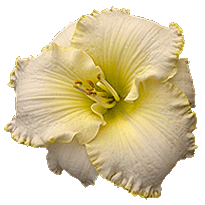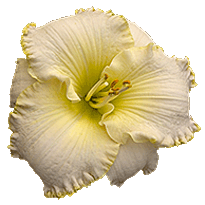




BAND refers to a darker colored area of a blossom that surrounds, or “bands,” the throat and is positioned just above the watermark, if present, on the petals only, as distinguished from an “eye” which appears on both the petals and the sepals.
BI-COLOR describes a blossom in which the sepals (the outer blossom segments) are of a completely different color than the petals (the three inner blossom segments). Compare to “bi-tone.”
BI-TONE describes a blossom in which the petals and sepals display different shades of the same basic color. The petals carry the darker shade, the sepals a lighter shade, as distinguished from REVERSE BITONE where the petals carry the lighter shade, and the sepals the darker shade.
BLEND describes a blossom whose basic color is comprised of an intermingling of two or more colors.
BORDER a daylily is said to have a border when it displays a distinctly different color along the edges of the blossom segments.
BRANCH, BRANCHING refers to the daylily scape’s branchlets each of which contains a cluster of buds.
BUD BUILDING refers to the characteristic of some daylily plants to continue to form new buds at the terminals of scapes after the scape has already begun to bloom.
BUD COUNT refers to the number of buds produced on a single daylily scape.
CROWN refers to the small white core comprising the juncture of the roots with the foliage of the daylily. When dividing out daylilies it is imperative that some of the crown be present in each division for the division to survive.
CULTIVAR is a contraction of “cultivated variety.”
DOUBLE: A flower with additional sets of perianth segments set one-within-the-other ("hose-in-hose" style), and/or with the stamens converted to petal-like structures (petaloids). Also see: Perianth segments, Petaloid, Stamen.
"Super double": Having no functional stamens or pistils; usually with completely sterile petaloid stamens and duplication of petals or of petaloid stamens. Such a flower is fully sterile. Dr. Arlow B. Stout observed that he knew of no daylilies that met this definition.
"Para-double": Having at least some well-formed stamens or petaloids usually with some traces of anthers. Usually there is duplication of petals or petaloid stamens. There is abortion or sterilization of the pistil. Such a flower is sterile as a seed parent. Stout observed that H. fulva 'Flore Pleno' and H. fulva 'Variegated Kwanso' were the only two cultivars he knew that met this definition.
"Semi-double": Having only petaloids of some or, occasionally, all stamens. Usually the pistil is normal. Nearly all flowers of this class are potentially fertile in respect to some stamens and the pistil.
"Pseudo-double": Occasionally some flowers of daylilies have more than the normal number of parts within each whorl in the flower. When such a flower has four petals there are usually also four sepals, four stamens in each of the two whorls and four carpels the pistil. There is further increase in the number of parts until it is obvious that there is fusion and fasciation involving two somewhat distinct flowers. In such flowers there are apparently sporadic and incidental irregularities in development and growth that are of doubtful or incomplete genetic value. (Source: American Hemerocallis Society “Daylily Dictionary”)
DWARF (not to be confused with “miniature” which describes blossom size) describes daylilies whose scapes are twelve inches or less in height; it does not apply to bloom size.
EDGED, EDGES refers to the outer edges of the tepals of the daylily.
EXTENDED BLOOM is used to describe daylily flowers that remain open for sixteen hours or more.
EYE or EYE ZONE refers to a darker colored area that surrounds the throat on both the petals and the sepals, as distinguished from the “band” which appears only on the petals. While usually circular, recent cultivars are displaying substantial variation in the shape of their eyes.
FAN describes a single daylily plant with its own roots, crown, and foliage.
HALO is used to refer to a narrow or indistinct eye.
INTRODUCED, INTRODUCTION: A daylily is considered to have been introduced (or be an introduction) when it has been offered for sale to the public.
MIDRIB refers to the central vein running the length of a tepal. A “raised midrib” is substantially elevated from the surrounding portion of the blossom. “Midrib” may also refer to the main vein running down the center of a leaf.
MINIATURE describes daylily blossoms of less than three inches in diameter (not to be confused with “dwarf” which describes a daylily plant’s scape height).
NOCTURNAL refers to daylilies whose blossoms open late in the day and remain open through the night and perhaps into the next day.
PERIANTH SEGMENTS in daylilies this term is virtually synonymous with “tepals” and as such collectively refers to the petals and sepals.
PETALOIDS in daylilies is an adjectival reference to a plant part that resembles a petal i.e. petal-like.
PETALS are the top-most three “tepals” or “perianth segments” of the daylily blossom.
PICOTEE describes a specific type of edge on a flower, where the edge is of a different color than that of the flower's base color. Picotees can have borders or margins which are lighter or darker, but they should be of a contrasting color, i.e., white edge on a red flower or red edge on an eyed flower. The only criterion is that the edge be of a contrasting color as the base of the flower; it can sometimes take bizarre shapes as well as hooks, horns, teeth, bubbles, braids, or fringe. All picotees are edges, but not all edges are picotees. All picotees are picoteed edges. (Source: American Hemerocallis Society “Daylily Dictionary”)
PISTIL refers to the female reproductive organ of the daylily. At its base in the throat of the daylily blossom is the ovary from which a long “style” extends ending in the stigma, the swollen flared tip of the pistil.
POLLEN the sperm of the daylily, the yellow dust found in the anthers.
POLLINATION occurs when the pollen from the anthers is placed on the stigma of the pistil. This can occur naturally by wind or insects, or be done intentionally by a person, said person thereby becoming a daylily “hybridizer.” (Note the change in spelling from “pollen.”).
POLYCHROME describes daylily blossom that contains many different colors without the presence of a band.
RECURVED describes the form of a daylily wherein the petals and sepals curve under and back toward the stem, yielding a round appearance to the blossom.
REGISTERED: A cultivar (clone) has been registered when its description and an acceptable name have been approved by the registrar appointed by the American Hemerocallis Society, the official international authority for all Hemerocallis registrations. The names of the originator and introducer (if introduced) are also recorded. Only one cultivar may be registered under a given name. (Source: American Hemerocallis Society “Daylily Dictionary”)
REVERSE BITONE: (see “bitone”)
SCAPE is the name given to the daylily flower stalk.
SCULPTED, SCULPTURED is used to describe the presence of a distinct three-dimensional quality to the surface of the petals.
SELF describes a daylily blossom in which all tepals are of the same color, ignoring the throat, which may be of a different color. (Compare “COMPLETE SELF” in which all blossom parts -- tepals, throat, pistil, and stamens -- are of the same color.)
SEPALS are the outer-most three “tepals,” “petaloids,” or “perianth segments” of the daylily blossom.
SPIDER describes the form of a daylily with long, narrow blossom segments. True spiders are daylilies in which a length-to-width ratio is 4 to 1 or greater.
STAMENS: Typically, daylily blossoms have six stamens attached at the base of the throat and extending out as slender “filaments.”. topping each filament is the anther, laden with pollen, the sperm cells of the daylily
SUNFAST describes a daylily blossom’s ability to withstand a full day in hot sun, retaining its color and texture with little deterioration.
TEPALS is a term that collectively refers to the petals and sepals of the daylily blossom.
THROAT The throat comprises the very center of the daylily blossom where the pistil, stamens, and sepals join.
VEINING describes a vein like color pattern on the tepals of the daylily blossom wherein the veins are of a contrasting color to that of the tepals themselves.
WATERMARK describes a zone of lighter color than the petals outside of and surrounding the throat. If a band, an eye, or a halo is present, the watermark would lie between it and the throat
Climate Considerations for Daylilies
Winter Care for Daylilies-Zone 5
Back to - Daylily Article Index

| Home Page | Our Daylilies | Daylily Cultivation Article Index |
| Information Center | Site Map | Offsite Links |
Internet Explorer 5+
Mozilla Firefox 2+
(You can download either of the browsers listed above by clicking on their name link)







